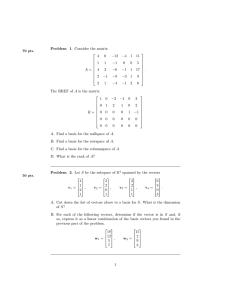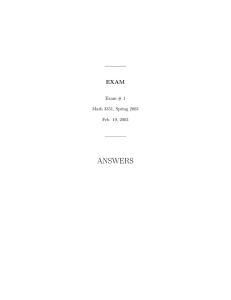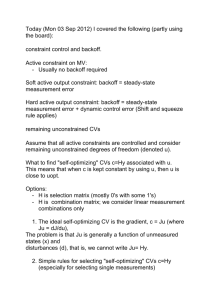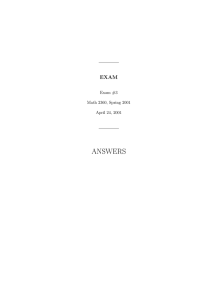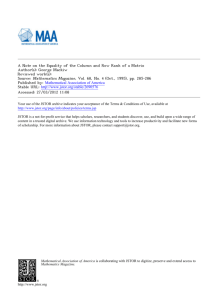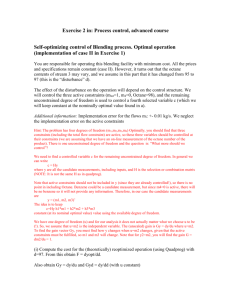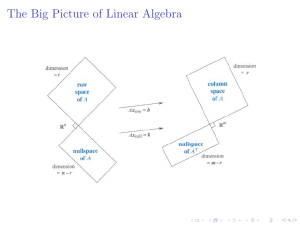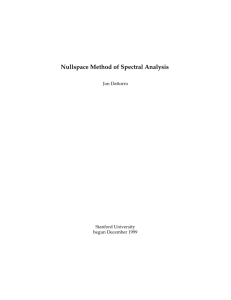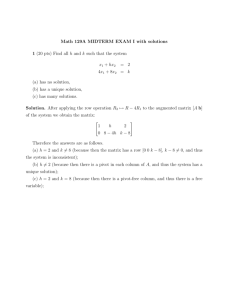ANSWERS EXAM Exam # 2 Take-home Exam
advertisement
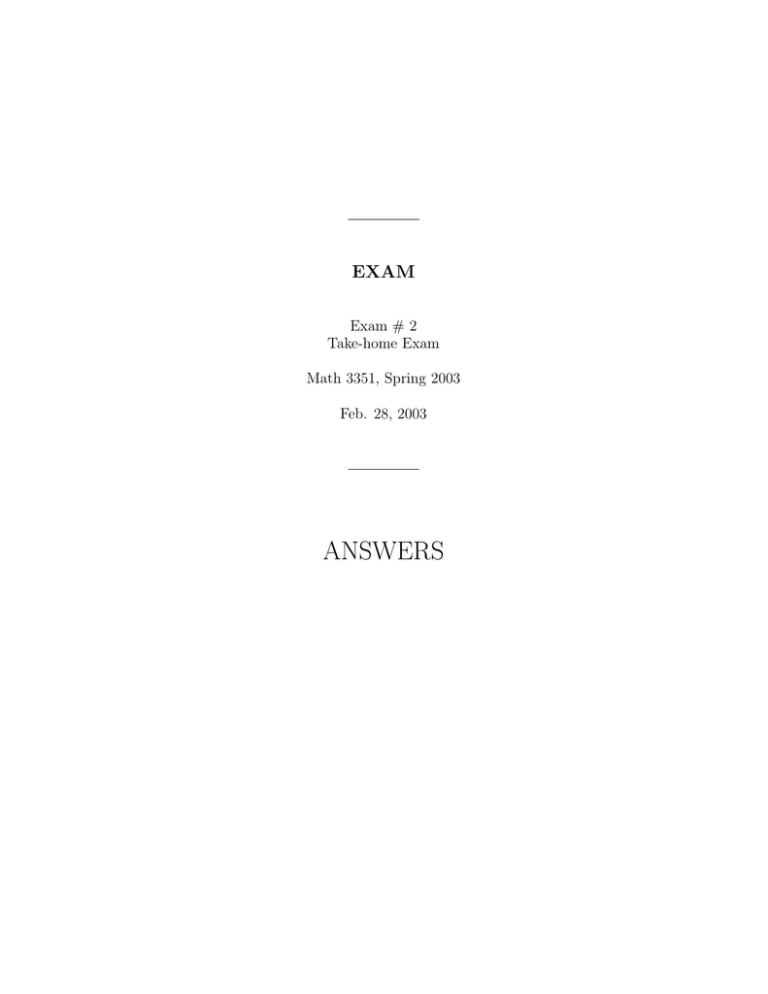
EXAM
Exam # 2
Take-home Exam
Math 3351, Spring 2003
Feb. 28, 2003
ANSWERS
i
70 pts.
Problem 1. Consider the matrix
4 0 −12 −4 1 11
1 1
−1
0 0 5
−6 −1 1 17
A= 4 3
.
2 −1 −8 −3 1 3
2 1
−4 −1 2 6
The RREF of A is the matrix
1
0
R=
0
0
0
0 −3 −1 0
1
2
1
0
0
0
0
1
0
0
0
0
0
0
0
0
3
2
−1
0
0
A. Find a basis for the nullspace of A.
Answer :
The nullspace is the space of solutions of the system Ax = 0. Since R is row
equivalent to A, the system Rx = 0 has the same solutions. So, we read off
the solutions from R, using zero as the right-hand side of the system.
Looking at R, call the variables x1 through x6 . Then x1 , x2 and x5 are
leading variables and x3 , x4 and x6 are free variables, say
x3 = α
x4 = β
x6 = γ.
Reading the rows of R from the bottom up gives the equations
x5 − x6 = 0 =⇒ x5 = x6 = γ
x2 + 2x3 + x4 + 2x6 = 0 =⇒ x2 = −2x3 − x4 − 2x6 = −2α − β − 2γ
x1 − 3x3 − x4 + 3x6 = 0 =⇒ x1 = 3x3 + x4 − 3x6 = 3α + β − 3γ.
Putting these equations together gives the family of solutions
x1
3α + β − 3γ
3
1
−3
x2 2α − β − 2γ
2
−1
−2
x3
α
=
= α 1 + β 0 + γ 0
x4
0
β
0
1
x5
0
0
1
γ
x6
γ
0
0
1
1
Thus, as we discussed, the vectors
3
1
−1
2
1
, 0 ,
1
0
0
0
0
0
−3
−2
0
0
1
1
form a basis for the nullspace of A.
B. Find a basis for the rowspace of A.
Answer :
A basis for the rowspcae is given by the nonzero rows in the RREF of A.
Thus, the vectors
1 0 −3 −1 0 3 ,
0 1 2 1 0 2 ,
0 0 0 0 1 −1
form a basis of the rowspace of A.
C. Find a basis for the columnspace of A
Answer :
To find a basis for the columnspace of A, we find the columns in R that
contain the leading entries (columns 1,2 and 5) and take the corresponding
columuns from the original matrix A. Thus, the vectors
1
0
4
0
1
1
4 , 3 , 1
1
−1
2
2
2
1
form a basis for the columnspace of A.
D. What is the rank of A?
50 pts.
Problem 2. Let S be the subspace of R4 spanned by the vectors
4
2
3
6
1
2
2
8
v1 =
v2 =
v3 =
v4 =
2 ,
0 ,
1 ,
0 .
1
1
1
3
2
A. Cut down the list of vectors above to a basis for S. What is the dimension
of S?
Answer :
We form the matrix
4 2 3 6 18
1 2 2 8 12
A = v1 | v2 | v3 | v4 | w1 | w2 =
2 0 1 0 5
1 1 1 3 7
15
2
.
9
3
The RREF of A is
1 0 0 −2 0
4
0 1 0
1 0 −2
.
R=
0 0 1
4 0
1
0 0 0
0 1
0
In the part of R to the right of the bar, we see that the first three columns
of R are independent and that the fourth column is a linear combination of
the first three. The same must be true for A, we we conclude that v1 , v2 , v3
is a basis for S. Since S has a basis with three elements, the dimension of
S is 3.
B. For each of the following vectors, determine if the vector is in S and, if
so, express it as a linear combination of the basis vectors you found in the
previous part of the problem.
18
15
12
2
w1 =
w2 =
5 ,
9
7
3
Answer :
In the matrix R above, we see that the 5th column is not a linear combination of the first 4 columns (because of the last row), so w1 is not a linear
combination of v1 , v2 , v3 , so w1 ∈
/ S.
From the matrix R above, we see that col6 (R) = 4 col1 (R) − 2 col2 (R) +
col3 (R). The same must be true about the columns of A, so we have
w2 = 4v1 − 2v2 + v3 ,
and so w2 ∈ S.
50 pts.
Problem 3. Let A be a 6 × 8 matrix and let B be a 7 × 7 matrix.
3
A. What is the largest possible value of the rank of A?
Answer : 6.
B. If the nullspace of A has dimension 5, what is the rank of A?
Answer :
The rank theorem says the rank plus the nullity of A must equal the number
of columns. The number of columns is 8, and we’re given that the nullity is
5, so we must have rank(A) = 3
C. If the rowspace of B has dimension 4, what is the dimension of the nullspace
of B?
Answer :
The rank is equal to the dimension of the rowspace or columnspace. Thus,
we know rank(B) = 4. The rank plus the nullity of B is equal to 7 (the
number of columns). Thus, the nullity of B is 3. By definition, the nullity
is the dimension of the nullspace, so the nullspace of B has dimension 3.
40 pts.
Problem 4. Let
−4
A=
−3
4
.
4
Find the characteristic polynomial of A and the eigenvalues of A.
Answer :
The characteristic polynomial p(λ) is given by
p(λ) = det(A − λI)
−4 − λ
4
= −3 4 − λ
= (−4 − λ)(4 − λ) − (−3)(4)
= −16 + 4λ − 4λ + λ2 + 12
= λ2 − 4.
The characteristic polynomials factors as λ2 − 4 = (λ − 2)(λ + 2), so the roots
(eigenvalues) are 2 and −2.
60 pts.
Problem 5. In each part you are given an matrix A and its eigenvalues. Find
a basis for each of the eigenspaces of A. Determine if A is diagonalizable, and if it is, find a matrix P and a diagonal matrix D so that
P −1 AP = D.
4
A.
0
A = −1
−1
1 1
3 0 ,
2 1
Eigenvalues = 1, 2.
Answer :
For the eigenvalue 1, we have
−1
A − λI = A − I = −1
−1
1 1
2 0
2 0
The reduced row echelon form of A − I is
1 0 −2
R1 = 0 1 −1
0 0
0
We want to find the nullspace of A − I, which is the same as the nullspace
of R1 . Call the variables x, y, z. Then z is a free variable, say z = α. The
second row of R1 gives us the equation y − z = 0, so we have y = α. The
first row of R1 gives us x − 2z = 0, so x = 2α. Thus, the nullspace of A − I
is parametrized by
x
2α
2
y = α = α 1 .
z
α
1
Thus, the eigenspace for λ = 1 is one dimensional with basis vector
2
1 .
1
Now consider the eigenvalue λ = 2. We have
−2 1
1
0 .
A − λI = A − 2I = −1 2
−1 2 −1
The RREF of A − 2I is
1 0 −1
R2 = 0 1 −1 .
0 0
0
Once again z is a free variable, say z = α The second row gives y − z = 0, so
y = α. The top row of R2 gives x − z = 0 and so x = α. Thus, the nullspace
of A − 2I is parametrized by
x
α
1
y = α = α 1 .
z
α
1
5
Thus, the eigenspace for eigenvalue λ = 2 is one dimensional with basis
vector
1
1 .
1
Since we’ve only found two independent eigenvectors, not three, we conclude
that A is not diagonalizable.
B.
8
9
9
2
0 ,
A= 0
−6 −9 −7
Eigenvalues = −1, 2.
Answer :
For the eigenvalue λ = −1 we have
9
9
9
3
0 .
A − λI = A + I = 0
−6 −9 −6
The RREF of A + I is
1
R1 = 0
0
0
1
0
1
0 .
0
Again, z is a free variable, say z = α. Then second row gives y = 0. The first
row gives x + z = 0, so x = −α. Thus, the nullspace of A + I is parametrized
by
x
−α
−1
y = 0 = α 0 .
z
α
1
Thus, the eigenspace for λ = −1 is one dimensional with basis vector
−1
0 .
1
Next, we consider the eigenvalue λ = 2. In this case we have
6
9
9
0
0 .
A − λI = A − 2I = 0
−6 −9 −9
The RREF of A − 2I is
1
R2 = 0
0
3/2
0
0
6
3/2
0 .
0
We see that y and z are free variables, say y = α and z = β. The top row
of R2 gives us the equation
3
3
x + y + z = 0,
2
2
so we have
3
3
x = − α − β.
2
2
Thus, the nullspace of A − 2I is parametrized by
3
x
−3/2
−3/2
− 2 α − 32 β
y =
= α 1 + β 0 .
α
z
0
1
β
Thus, the eigenspace for λ = 2 is two dimensional with basis
−3/2
−3/2
1 , 0 .
0
1
Since we’ve found three independent eigenvectors for the 3 × 3 matrix A, we
conclude that A is diagonalizable. If we set
−1 −3/2 −3/2
−1 0 0
1
0 , D = 0 2 0 ,
P = 0
1
0
1
0 0 2
then D is a diagonal matrix and P −1 AP = D.
80 pts.
Problem 6.
Let U = u1
u2 be the ordered basis of R2 where
1
1
u1 =
,
u2 =
.
3
2
A. Find the change of basis matrices SEU and SU E .
Answer :
The defining equation of SEU is U = ESEU or, in matrix terms, mat(U) =
ISEU , thus
1 1
SEU =
.
3 2
We have SU E = (SEU )−1 . Using a calculator to find the inverse, we get
−2
1
SU E =
.
3 −1
7
B. Let L : R2 → R2 be the linear transformation such that
L(u1 ) = 2u1 − 1u2
L(u2 ) = 3u1 − 5u2 .
Find [L]U U , the matrix of L with respect to the basis U.
Answer :
The defining equation of [L]U U is
L(U) = U[L]U U .
We are given the entries of L(U) = L(u1 ) L(u2 ) , so we find the matrix
that fills in the equation
2
3
2u1 − 1u2 3u1 − 5u2 = u1 u2
.
−1 −5
We conclude that
[L]U U =
2
3
−1 −5
.
C. Find the matrix of L with respect to the standard basis E of R2
Answer :
The change of coordinates formula for linear transformations is
[L]EE = SEU [L]U U SU E ,
so from our work above we have
1 1
2
3
−2
1
−8 3
[L]EE =
=
3 2
−1 −5
3 −1
−11 5
D. Let v be the vector
v=
2
.
3
a. Express v as a linear combination of u1 and u2 .
Answer :
By the change of coordinates formula for vectors, we have
[v]U = SU E [v]E
−2
1
2
−1
=
=
.
3 −1
3
3
8
Thus, we have
v = U[v]U
−1
= u1 u2
3
= −u1 + 3u2 .
b. Express L(v) as a linear combination of u1 and u2 .
Answer :
Recall that we were given L(u1 ) and L(u2 ) above. Thus, we can compute
L(v) = L(−u1 + 3u2 )
= −L(u1 ) + 3L(u2 )
= −(2u1 − u2 ) + 3(3u1 − 5u2 )
= 7u1 − 14u2 .
c. Express L(v) as a column vector.
Answer :
We know L(v) as a combination of u1 and u2 and we know u1 and u2 ,
so we have
L(v) = 7u1 − 14u2
1
1
=7
− 14
3
2
−7
=
.
−7
d. Check the last part against [L]EE v.
Answer :
We should have
L(v) = [L(v)]E
= [L]EE [v]E
= [L]EE v
−8 2
2
=
−11 5
3
−7
=
,
−7
which agrees with our result in the previous part.
9
40 pts.
Problem 7. Let S be the subspace of R6 spanned by the vectors
18
2
4
38
9
8
11
3
3
v1 =
v2 = ,
v3 = ,
v4 =
,
11
1
3
2
1
0
5
1
1
3
6
2
3
0
1
Let A be the matrix
0 −1
2
0
1
−3
−2
3 −4
1 −5
12
−8 15 −22
3
−25
56
A=
.
2 −3
4 −1
5 −12
−8 14 −20
3
−24
53
7
9 −25 −2
1
18
Define K by
K = {v ∈ S | Av = 0}.
Find a basis of K. Explain your reasoning.
Answer :
A check with a calculator shows that v1 , v2 , v3 , v4 are independent and so are
a basis of S. Thus, S has dimension 4. Let V be the ordered basis
V = v1 v2 v3 v4
of S.
Let T : S → R6 be the linear transformation induced by multiplication by
A, i.e., T (v) = Av. Of course, then
K = {s ∈ S | T (s) = 0}.
We have the ordered basis V for S and the standard basis E of R6 . Let B = [T ]EV
be the matrix of T with respect to these basis. The defining equation of B is
T (V) = E[T ]EV = EB.
(1)
Of course
T (V) = T (v1 ) T (v2 ) T (v3 ) T (v4 ) = Av1
10
Av2
Av3
Av4 .
In matrix terms, equation (1) becomes mat(T (V)) = mat(E)B = IB. Thus, we
have
B = mat(T (V))
= [Av1 | Av2 | Av3 | Av4 ]
−29 −5
−5
−5
95
19
19
19
447
87
87
87
=
−95 −19 −19 −19
418
82
82
82
263
37
37
37
,
using a calculator for the computations.
The formula for the action of T in coordinates is
[T (s)]E = [T ]EV [s]V = B[s]V .
Of course, [v]E = v, so this equation becomes
T (s) = B[s]V .
In other words, the following diagram commutes:
T
S −−−−→
[·]V y
R6
[·] =I
y E
R4 −−−−→ R6
B
where the vertical arrows are one-to-one correspondences. We conclude that
s ∈ K if and only is B[s]V = 0. In other words, [·]V gives a one-to-one correspondence between K and the nullspace of B.
A calculator computation gives the RREF of B as
1 0 0 0
0 1 1 1
0 0 0 0
R=
0 0 0 0 .
0 0 0 0
0 0 0 0
Call the variables x1 , . . . , x4 . We see that x3 and x4 are free variables, say
x3 = α and x4 = β. The second row of R gives the equation x2 + x3 + x4 = 0,
so x2 = −α − β. The top row of R gives x1 = 0. Thus, the nullspace of B is
parametrized by
x1
0
0
0
x2 −α − β
=
= α −1 + β −1 .
x3 α
1
0
x4
β
0
1
11
So, a basis for the nullspace of B is given by
0
0
−1
−1
w1 =
1 , w2 = 0 .
0
1
Thus, a basis for K is given by the vectors s1 and s2 such that [s1 ]V = w1
and [s2 ]V = w2 . We calculate that
s1 = V[s1 ]V
= Vw1
= v1
v2
v3
= −v2 + v3
2
9
3
= −
1 +
1
1
2
−1
0
=
2 .
−1
0
0
−1
v4
1
0
4
8
3
3
0
1
and
s2 = V[s2 ]V
= Vw2
= v1
v2
v3
= −v2 + v4
1
−3
−1
=
2 .
−1
0
12
0
−1
v4
0
1
13
